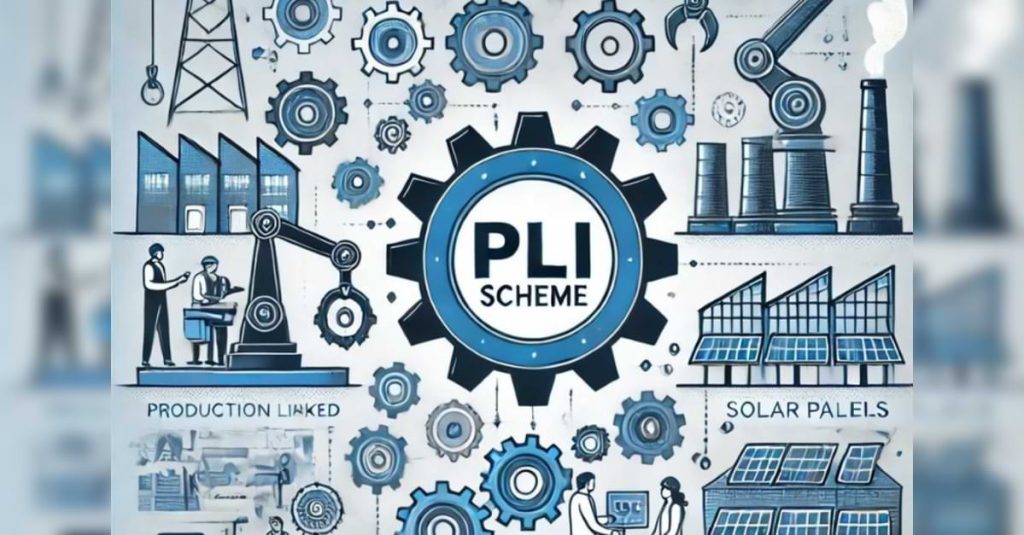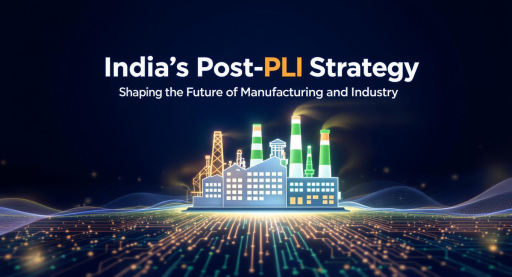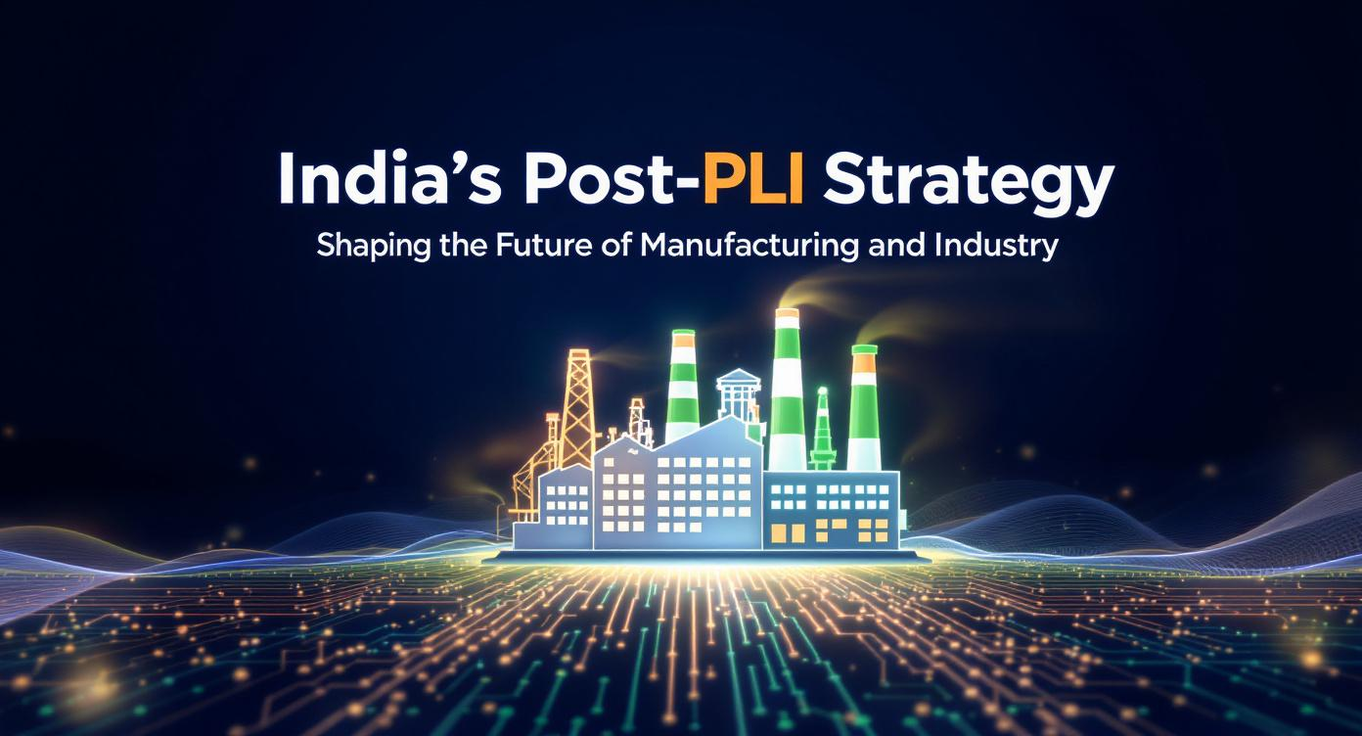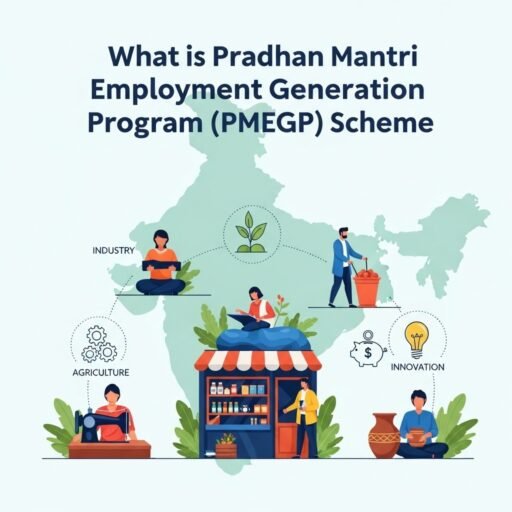Introduction
India’s economic framework is now at a crucial juncture. A “Post-PLI” strategy has become a point of debate among stakeholders as the latest PLI scheme India—valued at ₹23 billion—nears its expiration. Where do we go from here? Will India come to the rescue of laggard industries like steel and solar, which are still under the microscope? Can alternative channels plug the gaps left by this ambitious yet, in some ways, disappointing scheme? The questions remain critical.
Reviewing the PLI Scheme India and Its Legacy
The PLI scheme in India, implemented in 2020, aimed to garner investments, boost export growth, increase domestic manufacturing, and challenge China’s international dominance. Under the scheme, performance-linked incentives were extended to international and domestic companies in 14 core sectors. The bold vision was to take India’s manufacturing share from about 15% to 25% of its GDP by 2025.
The results, however, paint a colder picture. By October 2024, companies had yielded only 37% of targeted production and received less than 8% of earmarked incentives (
19 billion in investment commitments**, constant delays thwarted many in recouping costs or meeting production benchmarks. Consequently, manufacturing’s share of GDP slipped from 15.4% to 14.3%.
This indicates why analysts argue that, despite success stories in sectors like mobiles and pharma, sectors like steel and solar have fallen short. This contradiction highlights the need for a rethink of India’s Post-PLI Strategy.

Why India Needs a Post-PLI Strategy
Letting the PLI scheme in India end without a replacement is a sure way to halt manufacturing momentum. A post-PLI strategy must bridge the policy, institutional, and implementation gaps revealed by the scheme.
- Avoiding a Policy Cliff: A ₹23 billion scheme can’t just be cut off. A lapsed PLI scheme in India would leave the 14 target sectors without an adequate support framework, potentially disillusioning investors.
- Targeting Underperforming Sectors: While mobile and pharmaceutical sectors thrived, steel, solar, textiles, and specialty steel were not nearly as fortunate. A robust post-PLI strategy must prioritize eliminating its unique bottlenecks, from high input costs to skill shortages.
- Speeding up Incentives and Cutting Red Tape: Delays in incentive disbursements caused severe problems for firms. Evidence from the PLI scheme in India shows that timely payments are a primary concern that any post-PLI strategy must address.
Exploring Subsidy Alternatives After the PLI Scheme
As the PLI scheme in India ends, officials are considering using investment reimbursement rather than output-linked payouts. This is how the post-PLI strategy might pan out:
1. Upfront Investment Reimbursement Model
The Post-PLI Strategy India provides advanced subsidies based on plant capacity or capital expenditure, rather than linking incentives to postponed output. This helps ease working capital hassles and eliminates the bureaucratic hurdles faced in the PLI scheme.
2. Equipment Subsidies
India could help companies acquire specific equipment—such as solar module lines or high-grade steel mills—through either grants or low-interest loans. This would specifically address the production gaps made explicit by the former PLI scheme in India.
3. Sector-Specific Clusters and Industrial Corridors
Manufacturing clusters, particularly for solar, steel, and EV batteries, can promote economies of scale, shared infrastructure, and skill ecosystems, all aligned with a comprehensive post-PLI strategy.
4. EV and Clean-Energy Incentives
Broadening the range of incentives for EVs, batteries, green hydrogen, and solar technologies can help achieve the larger sustainability goals in a post-PLI framework.
Find all of our books here.
Who’s Losing Out? Steel & Solar in the Post-PLI Era
Some sectors are more vulnerable to subsidy withdrawal:
- Steel: Out of 58 steel projects under the PLI scheme in India, 14 backed off due to slow progress. Without a scheme extension, hundreds of thousands of tonnes of capacity may stand still. Investment refunds or capital equipment subsidies could provide the necessary drive—important elements of any credible post-PLI strategy.
- Solar: Although companies like Reliance, Adani, and JSW signed up, most fell short of their PLI targets, with eight out of 12 unlikely to meet them. The post-PLI strategy should include mechanisms such as interest subvention or rationalizing import tariffs to ensure support for solar manufacturing, which is critical for India’s clean energy goals.
- EV Batteries & Green Hydrogen: These sectors must be included in the post-PLI strategy, as they require scale and affordability to remain competitive in the emerging global green transition.
Read More: PLI Success Stories in India
The Broader Industry View: Risks & Opportunities
- Bureaucracy & Delivery: The PLI scheme in India revealed how red tape delayed rebates. New post-PLI strategies must streamline approvals, potentially using a single-window digital portal.
- Skill & Supply Chain Gaps: The solar sector faces a significant skill deficit. A post-PLI strategy should include training subsidies and public-private partnerships to build a skilled workforce.
- Financing and Cost Structures: A Large upfront investment is a barrier. Upfront investment reimbursement models can unlock capital. Additionally, financial products like low-interest green bonds can further ease adoption.
- Global Trade and Tariffs: Protective tariffs must be balanced with component import costs—a key lesson from the PLI scheme in India. A post-PLI strategy could tie performance and localization with import duty adjustments to ensure a smooth supply chain, especially for solar.
The easiest way to explore, compare, and start your business journey.
A Roadmap for a Robust Post-PLI Strategy
Below is an illustrative action plan:
| Objective | Action Point |
| Smooth Transition | Launch an investment reimbursement scheme before the PLI lapsess. |
| Sector Focus | Develop tailored models for steel, solar, EV batteries, pharma, and mobiles. |
| Disbursement Efficiency | Implement a digital window with a 60-day timeline for verifications. |
| Skill Development | Incentivize certification programs in affected sectors. |
| Cluster Development | Create PPP-based industrial parks with shared utilities. |
| Financing | Introduce green bonds, MSME loan subvention, and capex grants. |
| Tariff Rationalization | Link adjustable duties to localization benchmarks. |
| Monitoring & Feedback | Conduct quarterly reviews and mid-course corrections. |
Voices from Experts and Industry
Analysts have a bittersweet view of the scheme’s impact:
This mega scheme is possibly the last chance we had to revive our manufacturing sector.”— Dhar, Council for Social Development
This sentiment speaks to the concerns of trade ministry officials, who say the scheme was burdened by red tape. Reforms must be a core part of the new post-PLI strategy. However, the pharma and mobile segments bring optimism—they are clear winners from the PLI scheme, demonstrating sound execution. A post-PLI strategy could amplify these successes.
Find the Best Idea for Yourself With our Startup Selector Tool
Conclusion: A Defining Moment for India’s Manufacturing
This is a defining moment for Indian manufacturing. As the PLI scheme India nears its closure, it puts the country at an important crossroads. Will it retract, or will it reinforce its commitment to industrial policy? The emerging post-PLI strategy offers nuanced and flexible pathways—rewarding investments while tackling sector-specific challenges and simplifying implementation.
In a global environment of reshuffling supply chains and a transition toward a green economy, India must act decisively. A well-designed post-PLI strategy could re-energize solar, steel, and tech manufacturing, ensuring that India’s aspirations for scale and self-reliance do not fade.
Otherwise, the country risks losing vital ground to its regional rivals. One thing is certain: the industrial future of India in the post-PLI age requires nothing less than visionary policy matched with flawless execution.
For more information, check out this Related video.
Frequently Asked Questions (FAQ)
Q1: What is the PLI scheme in India, and what was its original goal?
A: The Production Linked Incentive (PLI) scheme in India, launched in 2020, aimed to boost domestic manufacturing, attract investment, increase exports, and reduce reliance on Chinese imports across 14 key sectors. Its goal was to raise manufacturing’s share of India’s GDP from around 15% to 25% by 2025.
Q2: Why is there a debate about what comes after the PLI scheme India ends?
A: As the ₹23 billion PLI scheme India approaches its close, concerns have arisen over continuing support for underperforming sectors like steel and solar, which haven’t met targets. Stakeholders worry about maintaining manufacturing momentum and attracting investment in a post-PLI environment.
Q3: Which sectors succeeded and which fell short under the PLI scheme in India?
A: While mobile and pharmaceutical sectors thrived, sectors like steel, solar, and textiles struggled to achieve production and incentive targets due to delays, high costs, and unmet capacity goals.
Q4: What is the biggest lesson from the implementation of the PLI scheme in India?
A: Timely disbursement of incentives and reduction in bureaucratic red tape are crucial—many companies faced delays in payments and approvals, which hindered performance and investment recovery.
Q5: What alternatives to output-based incentives are being considered for India’s post-PLI strategy?
A: Upfront investment reimbursement models, equipment subsidies, and incentives for sectors like EVs and green hydrogen are being considered to simplify processes and address sector-specific needs.







